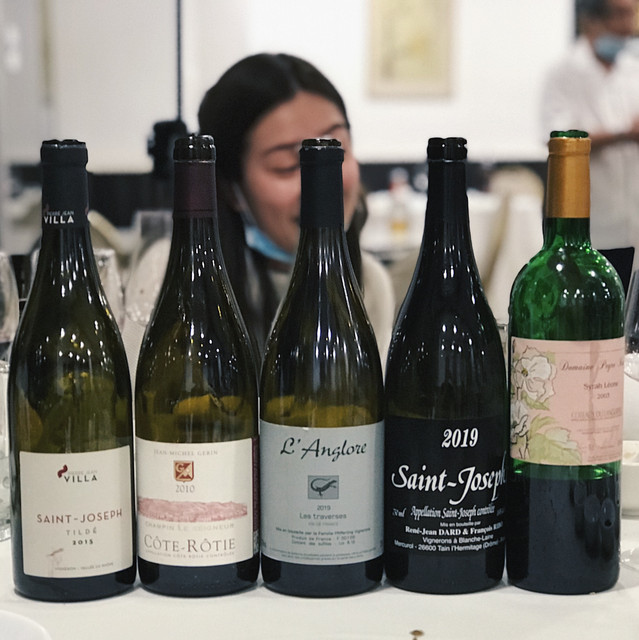QUE SYRAH SYRAH - Chaoshan Cuisine (14/9/2021)
Syrah night which was very educational. Learning points - I should (a) stick to traditional producers, (b) be patient enough to catch wines at their right drinking window - only the two elder statesmen of the lot were anywhere near ready, (c) it is really easy to guess the producer if you play the man (or with some hints). N.B. I brought an extra bottle because once I smelled the l’Anglore I knew I wouldn’t like it even without tasting, but turned out the Villa wasn’t great either unfortunately.
-
2015 Pierre Jean Villa St. Joseph Tilde - France, Rhône, Northern Rhône, St. Joseph
Relatively new domaine. Old-school in terms of aroma - some funk and meatiness, but rather modern terms of oak use and extraction. Late picking too I suspect since apparently he was trained at Clos de Tart. Very plummy, the oak dominated at first to give it a density that the fruit could not support, no finesse to the wine. Settled down with time to become more classic northern Rhone, but I would prefer a more restrained style. -
2010 Jean-Michel Gerin Côte-Rôtie Champin le Seigneur - France, Rhône, Northern Rhône, Côte-Rôtie
I’ve only tried la Vialliere from this producer and to be honest I have avoided it like a plague since then. Was told by the person who brought this that this was the best bottle thus far, and that he didn’t like la Vialliere either. In any case, this was a lovely drink. Managed to get the producer correct with an easy hint. Secondary aroma on the nose that was rather Burgundy-like in terms of sous-bois, greenness and spice. Showed a lot of classicism and the Sensory brought out the elegance of the wine very well. Thoroughly impressed even though this was the basic Côte-Rôtie. -
2003 Domaine de Peyre Rose Coteaux du Languedoc Clos Syrah Leone - France, Languedoc Roussillon, Languedoc, Coteaux du Languedoc
With the Bordeaux-like nose of eucalyptus, everyone was in Australia for this. But after being told it was from France, it was quite easy to narrow down the producer. Very classic and tight still, enjoyed this much more than 2004 which was rather disjointed. As someone mentioned, perhaps they overcompensated for the cool vs warm vintage. Very intense core of fruit that did not veer towards sweetness that should have suggested old-world, better with time but still a long way to go for this wine. -
2019 Dard et Ribo St. Joseph - France, Rhône, Northern Rhône, St. Joseph
I was leaning towards Côte-Rôtie with the acidity and elegance behind the dense purple fruit on this. Natural style but still clean despite what I have read, although the bubble gum nature was rather distracting for me. Out of all the wines this had the strongest olive note, some liquorice that I did not like. Better with air but I think the others liked this more than me. -
2019 Domaine de l’Anglore Les Traverses - France, Vin de France
70% Syrah, 30% Grenache. Rather disappointed with this after the very impressive rose that I loved. Made in a glou-glou, natural style with overbearing purple fruit that wasn’t in balance with the tartness of the wine. Bojo-like in a bad way. I have a 2013 of this and I dare not imagine how it tastes like.
